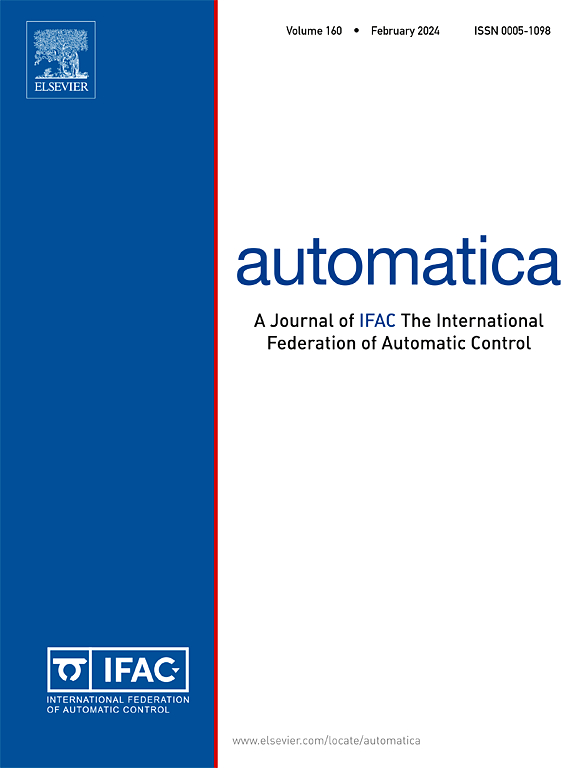A compensation-oriented algorithm for difference-driven identification under binary-valued observations and data packet dropout
IF 5.9
2区 计算机科学
Q1 AUTOMATION & CONTROL SYSTEMS
引用次数: 0
Abstract
This paper investigates the identification problem for finite impulse response (FIR) systems with binary-valued observations under event-triggered communication mechanism and data packet dropout. The challenge lies in the inability to distinguish between untriggered events and packet loss when no information is received, which prevents us from obtaining the statistical properties of the binary-valued sequence. A compensation-oriented difference-driven identification (CODD) algorithm is proposed to estimate the parameter by recovering the mean of the original binary-valued sequence, where different values for the observation estimates are assigned when receiving 0, 1 or nothing. Even though, the convergence analysis of the parameter estimate is still challenging since the assigned values are dependent. To tackle this difficulty, the estimate error is divided into two parts: an initial assigned value related part, which is demonstrated to be convergent through the construction of an auxiliary set, and the remaining component, which happens to be a convergent martingale-difference sequence. As a result, the almost sure convergence and the asymptotic normality of the CODD algorithm are established when data packet loss probability is less than . By calculating the communication rate, it is proven that the difference-driven mechanism can save 50% of the communication cost compared to original binary-valued systems. Furthermore, when data packet loss probability is high, an -channel compensation-oriented identification (-CODD) algorithm is constructed by utilizing retransmission of the each observation for times, which is designed based on the packet loss probability. The properties of -CODD algorithm including convergence, asymptotic normality and communication rate are established. Numerical simulations are illustrated to show the theoretical results.
二值观测和数据包丢失下差分识别的补偿导向算法
研究了具有二值观测值的有限脉冲响应(FIR)系统在事件触发通信机制和数据包丢失情况下的辨识问题。挑战在于当没有接收到任何信息时,无法区分未触发事件和数据包丢失,这使我们无法获得二值序列的统计特性。提出了一种基于补偿的差分驱动识别(CODD)算法,该算法通过恢复原始二值序列的均值来估计参数,其中当接收到0、1或无时,对观测值的估计值分配不同的值。尽管如此,参数估计的收敛性分析仍然具有挑战性,因为分配的值是相关的。为了解决这一困难,将估计误差分为两部分:与初始赋值相关的部分,通过构造辅助集证明是收敛的,其余部分恰好是收敛的鞅-差分序列。当数据包丢失概率小于12时,建立了CODD算法的几乎肯定收敛性和渐近正态性。通过对通信速率的计算,证明了差分驱动机制比原二值系统节省50%的通信成本。在丢包概率较高的情况下,基于丢包概率设计了m通道补偿型识别算法(m- codd),该算法利用每条观测数据的m次重传。建立了m-CODD算法的收敛性、渐近正态性和通信速率。通过数值模拟验证了理论结果。
本文章由计算机程序翻译,如有差异,请以英文原文为准。
求助全文
约1分钟内获得全文
求助全文
来源期刊

Automatica
工程技术-工程:电子与电气
CiteScore
10.70
自引率
7.80%
发文量
617
审稿时长
5 months
期刊介绍:
Automatica is a leading archival publication in the field of systems and control. The field encompasses today a broad set of areas and topics, and is thriving not only within itself but also in terms of its impact on other fields, such as communications, computers, biology, energy and economics. Since its inception in 1963, Automatica has kept abreast with the evolution of the field over the years, and has emerged as a leading publication driving the trends in the field.
After being founded in 1963, Automatica became a journal of the International Federation of Automatic Control (IFAC) in 1969. It features a characteristic blend of theoretical and applied papers of archival, lasting value, reporting cutting edge research results by authors across the globe. It features articles in distinct categories, including regular, brief and survey papers, technical communiqués, correspondence items, as well as reviews on published books of interest to the readership. It occasionally publishes special issues on emerging new topics or established mature topics of interest to a broad audience.
Automatica solicits original high-quality contributions in all the categories listed above, and in all areas of systems and control interpreted in a broad sense and evolving constantly. They may be submitted directly to a subject editor or to the Editor-in-Chief if not sure about the subject area. Editorial procedures in place assure careful, fair, and prompt handling of all submitted articles. Accepted papers appear in the journal in the shortest time feasible given production time constraints.
 求助内容:
求助内容: 应助结果提醒方式:
应助结果提醒方式:


